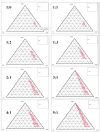QbD Approach for the Development of Tea Tree Oil-Enhanced Microemulgel Loaded with Curcumin and Diclofenac for Rheumatoid Arthritis Treatment
- PMID: 39451289
- PMCID: PMC11507205
- DOI: 10.3390/gels10100634
QbD Approach for the Development of Tea Tree Oil-Enhanced Microemulgel Loaded with Curcumin and Diclofenac for Rheumatoid Arthritis Treatment
Abstract
Rheumatoid arthritis, a chronic autoimmune disorder affecting millions worldwide each year, poses a significant threat due to its potential for progressive joint damage and debilitating pain if left untreated. Topical anti-inflammatory and analgesic treatments offer localized relief with reduced systemic side effects compared to conventional oral therapies, making them a promising option for managing rheumatoid arthritis. Therefore, the current study endeavored to formulate a microemulsion gel formulation loaded with diclofenac and curcumin for topical administration in the management of rheumatoid arthritis, utilizing Tea tree oil. The ratio of surfactant and cosurfactant was 4:1, assessed by pseudoternary phase diagram on the basis of the maximum emulsification region. The microemulsion underwent optimization using a Central Composite Rotatable Design (CCRD) with constraints of minimum particle size, polydispersity index, and maximum transmittance. The Curcufenac-T microemulsion had a particle size, polydispersity index (PDI), and transmittance of 151.82 ± 15.9 nm, 0.287 ± 0.021, and -5.78 ± 0.26 mV, respectively. DSC analyses confirmed the stability and compatibility of diclofenac and curcumin within the formulation. The microemulsion was changed into gel form by incorporating 1% carbopol-934. Skin permeation analysis revealed that the percentage of diclofenac permeated at 0.5 h from Curcufenac-T microemugel and the conventional gel was 12.1% and 3.9%, respectively, while at 12 h, the rates were 82.6% and 34.2%, respectively. In vitro permeability demonstrated significant potential for the effective delivery of diclofenac and curcumin to targeted sites, compared to conventional gel. Therefore, it was deduced that the Tea tree oil integrated diclofenac and curcumin microemulsion gel could enhance the effectiveness of diclofenac and serve as a promising vehicle for rheumatoid arthritis treatment.
Keywords: QbD; central composite rotatable design; curcumin; diclofenac; microemulsion gel; tea tree oil.
Conflict of interest statement
All authors assert that they have no known conflicting financial interests or personal affiliations that might have affected the work reported in this manuscript.
Figures








Similar articles
-
Curcumin Encapsulation in Geranium Oil Microemulsion Elevates Its Antibacterial, Antioxidant, Anti-Inflammatory, and Anticancer Activities.ACS Omega. 2024 Jan 23;9(5):5624-5636. doi: 10.1021/acsomega.3c08033. eCollection 2024 Feb 6. ACS Omega. 2024. PMID: 38343911 Free PMC article.
-
Controlled Release Gel Encompassing Curcumin Microspheres and Diclofenac Diethylamine for Feat Against Arthritis Inflammation.Curr Rheumatol Rev. 2020;16(2):110-119. doi: 10.2174/1573397115666191105142827. Curr Rheumatol Rev. 2020. PMID: 31738154
-
Development of Microemulsion Based Nabumetone Transdermal Delivery for Treatment of Arthritis.Recent Pat Drug Deliv Formul. 2018;12(2):130-149. doi: 10.2174/1872211312666180227091059. Recent Pat Drug Deliv Formul. 2018. PMID: 29485013
-
Transdermal delivery of diclofenac using water-in-oil microemulsion: formulation and mechanistic approach of drug skin permeation.Pharm Dev Technol. 2014 May;19(3):373-84. doi: 10.3109/10837450.2013.788658. Epub 2013 May 1. Pharm Dev Technol. 2014. PMID: 23634780
-
Antipsoriatic microemulsion gel formulations for topical drug delivery of babchi oil (Psoralea corylifolia).Methods Find Exp Clin Pharmacol. 2008 May;30(4):277-85. doi: 10.1358/mf.2008.30.4.1185802. Methods Find Exp Clin Pharmacol. 2008. PMID: 18773122
References
-
- Chauhan K., Jandu J.S., Brent L.H., Al-Dhahir M.A. StatPearls. StatPearls Publishing; Treasure Island, FL, USA: 2024. [(accessed on 3 April 2024)]. Rheumatoid Arthritis. Available online: http://www.ncbi.nlm.nih.gov/books/NBK441999/ - PubMed
Grants and funding
LinkOut - more resources
Full Text Sources

